SKINNY WATER, HIGH SUMMER TROUT!
Words & Images by Andrew Harding
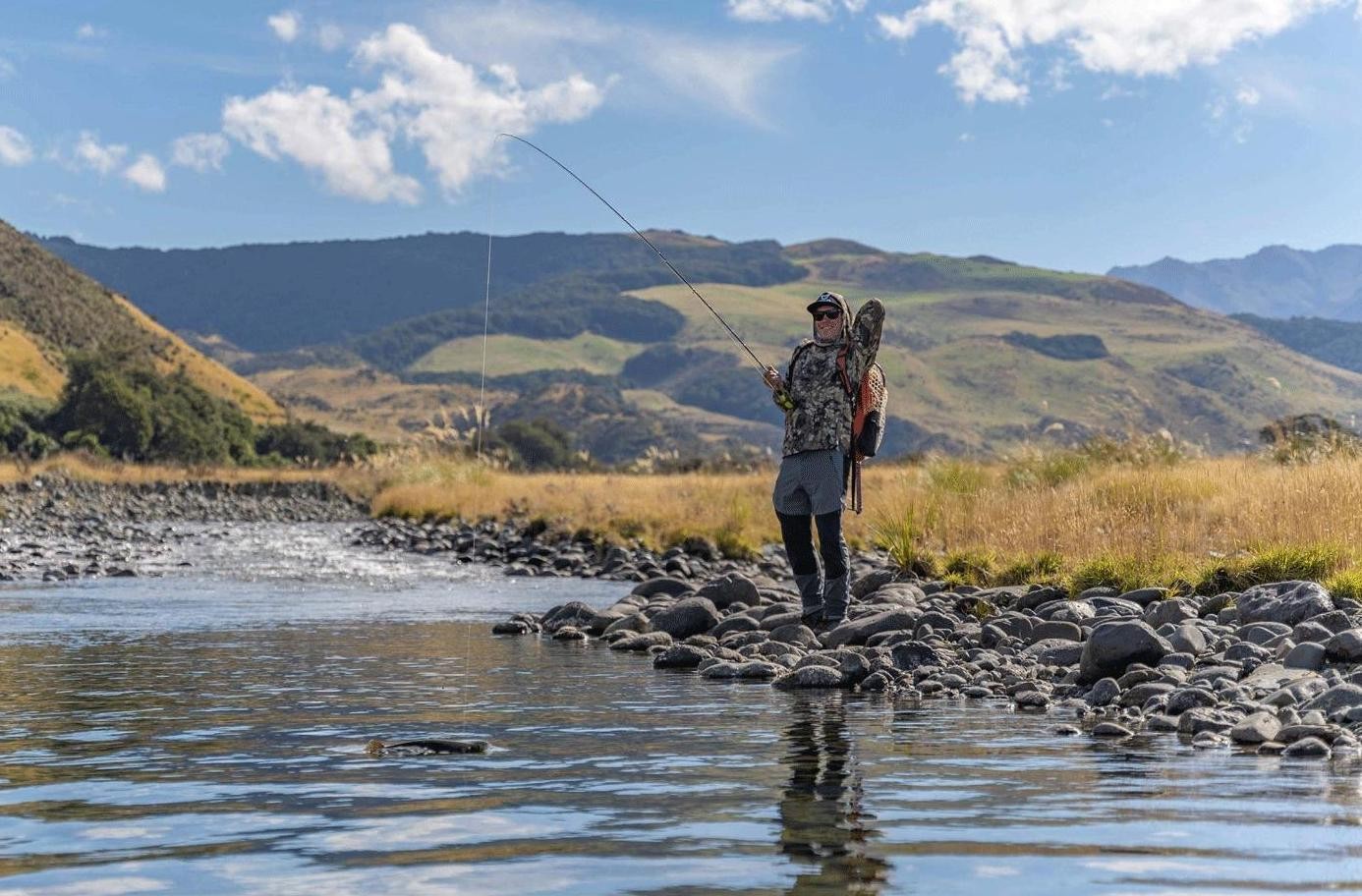
As the heat of a Kiwi summer commences and rivers begin to recede, trout in skinny, lowwater river conditions present both a real challenge and the opportunity of an often-thrilling pursuit. Diminishing water levels require a nuanced approach and a keen understanding of trout behaviour. We might look a little out of place in the public eye dressed head to toe in camo, a wide-brimmed hat and walking like a ninja… but subtlety is the absolute key to success! The ninja-walk… a low-profile stance and slow-motion-like walk to reduce disturbance will help avoid alerting fish.
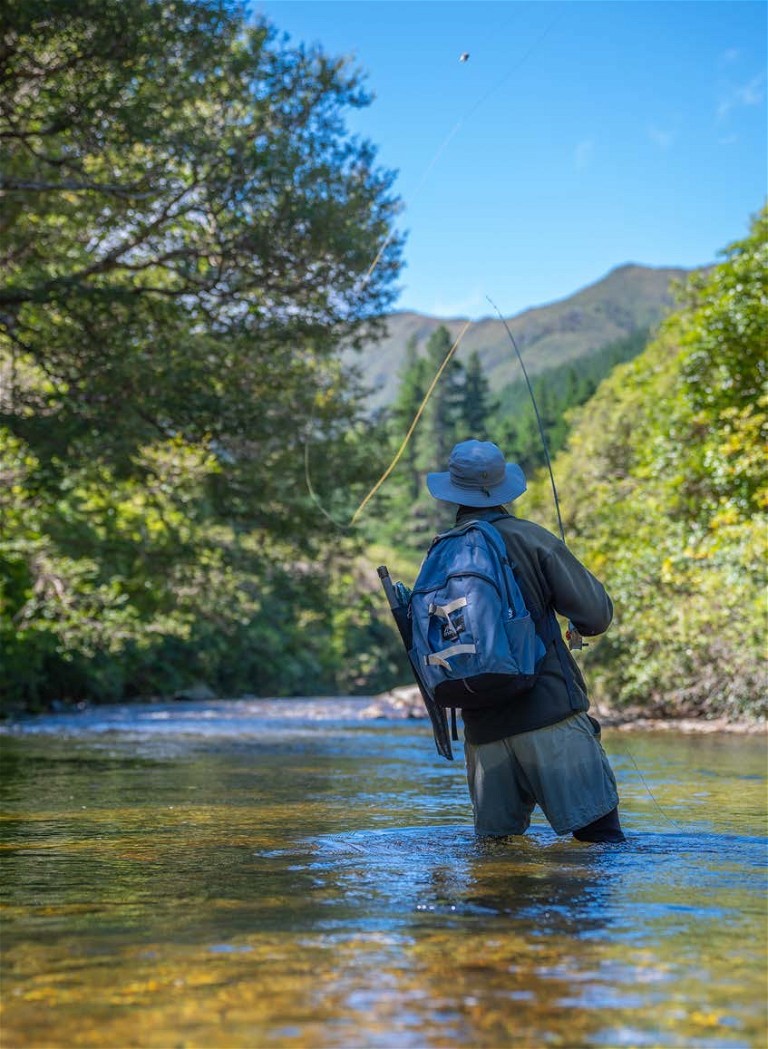
As water temperatures rise, trout become more selective in their feeding patterns, seeking refuge in the cooler, oxygenated water, and the drop-offs leading into deeper pools, often limiting feeding to early in the day and late in the evening when water temperatures are cooler. Typically, in the faster pocket water of boulder-strewn waterways, water temperatures can be as much as five degrees cooler than in the larger still pools and tail-outs, so drop-offs and fast pocket water are your friends in summer.
Tippet size in summer conditions should be downsized along with the size of your flies. While during the early season, a tippet strength of 5-6lb may suffice, high summer trout will require 3-4lb tippet if you are to pull off any chance of success. I prefer to work in tippet diameter over the ‘X’ system and ‘lb’ ratings that can vary so much between manufacturers. In general, early and late season work, and I find a tippet diameter of around 0.18 to 0.21mm ideal, dropping to between 0.15mm and 0.18mm in low water conditions and small waterways.
One sure-fire place on many rivers where you will find trout in summer is the ‘drop-off’ zone – that area where a river’s faster water spills over into a deeper pool. Typically this is a fine shingle bar, and a favoured feeding spot for trout. Careful observation will find them riding the pressure waves on the drop-off, just slightly back, weaving backwards and forwards intercepting any wayward drifting nymph or surface terrestrial. Additionally, the drop-off zone provides two of the most important factors in a trout’s world… food and security! A quick flick of the tail upon any unfamiliar movement sees them retreat to the deepwater safety of the pool where they will often stay for several hours before returning to feed.
Hawkes Bay rivers are an example of a fishery where dropoffs are incredibly productive. In fact, during the height of summer, you’ll seldom find fish anywhere else! The security of deep pools flanked by deeply rooted willows provides a quick respite from danger, not to mention offering crucial shade and protection from the searing sun. To fish a drop-off successfully, you need to reach the trout’s feeding level, as they won’t expend any more energy than is necessary in high water temperatures. This often means getting down… and getting there fast! A dry/dropper system is ideal in such situations – a heavily weighted, sparsely tied #16 tungsten nymph with a darkcoloured bead (not a gaudy gold bead) will usually bring success.
Whilst gold beads have their place on predominately rainbow trout fisheries, and in high, dirty water, the success rate of using black or grey beads on your nymphs in low water conditions cannot be denied, they simply work better and are far more natural to the trout than anything ‘flashy’.
I well recall a high-summer trip to Waipawa in Hawkes Bay to fish the Tukituki and Waipawa rivers, which both become weedy and eutrophic in lowsummer conditions and the trout seemingly shutting down in the high water temps, making for a real angling challenge! What few trout we did find were either riding drop-offs or sipping willow grubs and tiny nymphs in the foam lines of large pools, disregarding any offerings presented. Like the flick of a switch… a southerly rolled in, the skies darkened, and all trout encountered pounced on any fly presented, even gold-beaded nymphs! It really didn’t matter what the pattern was. And just as fast as this feeding frenzy started, it passed, the trout returning to their stubborn habits and refusing anything offered. This not-sosubtle temperature change was the catalyst for success that day, so when it gets hot and slow try and go out on colder, overcast days as an alternative.
Learn your local rivers and the differences each season offers – familiarity with the local insect life cycle, coupled with the ability to accurately imitate these insects with wellchosen fly patterns, elevates the chances of success. Moreover, low water conditions necessitate a thoughtful consideration of tackle and fly line choices in case you haven’t noticed! The ability to deliver finesse presentations is absolutely paramount. Leader lengths between 14-18 feet are the norm for fooling fish that have become more discerning in their feeding behaviour. Selecting flies that match the size and colour of the prevailing insect life will enhance your chances of a successful outing. Fly line colour is an often controversial topic; some argue that when fishing correctly, the fish will be nowhere near your fly line. Whilst this is true, there are some situations where you will need to ‘line’ a fish in order to get a drag-free drift. This is where subtley-hued fly lines with dull olive tapers on the business end prevail over gaudy, bright lines.
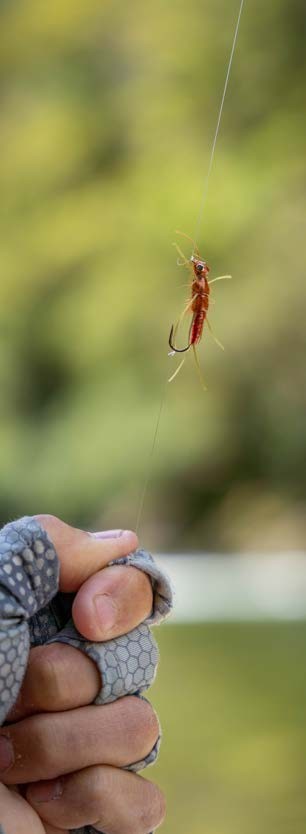
1) Getting down fast on the dropoff zone is paramount – this is where heavily weighted flies work well.
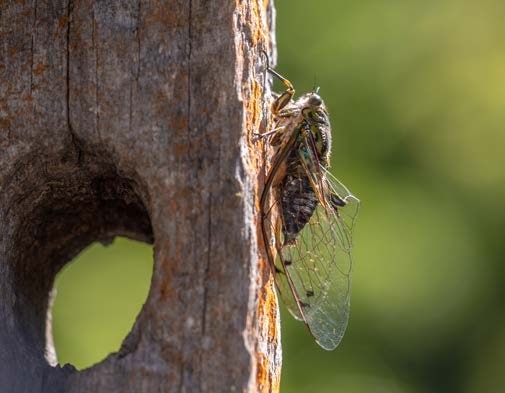
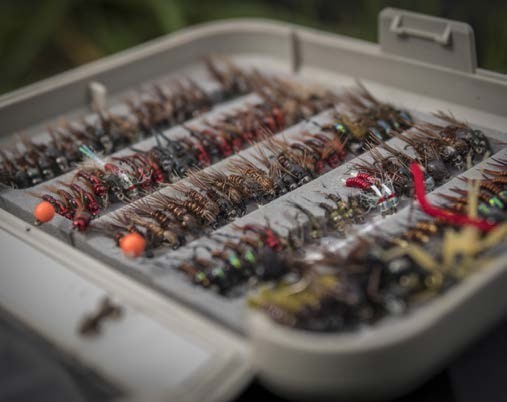
2 & 3) When in doubt in high summer conditions, go smaller... or go cicada!
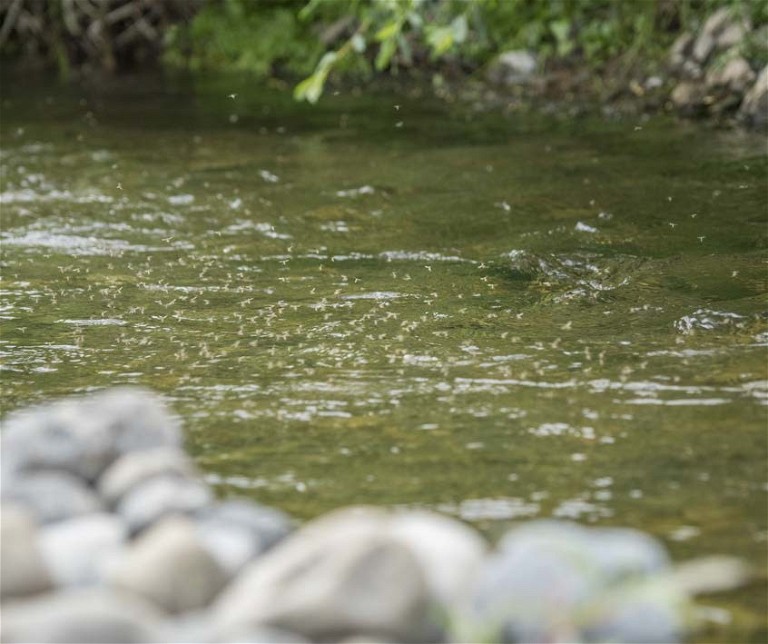
4) Match the hatch!
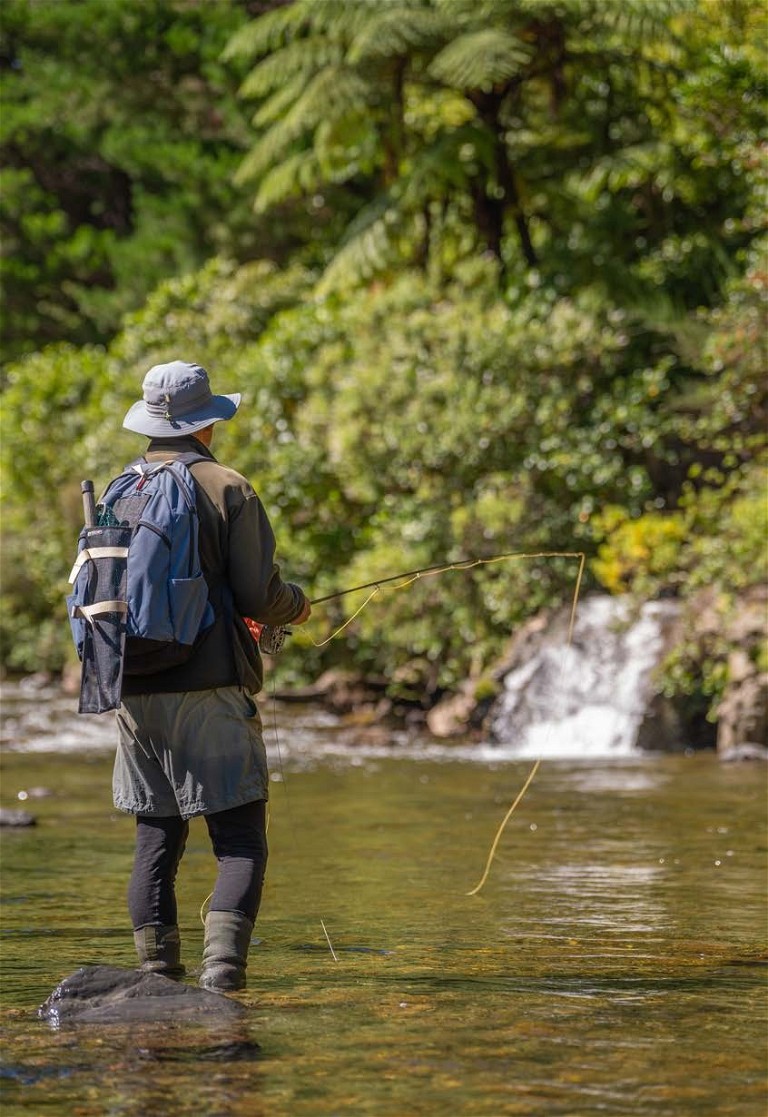
Searching the heads of deep pools where the cool water inflows is always a likely spot.
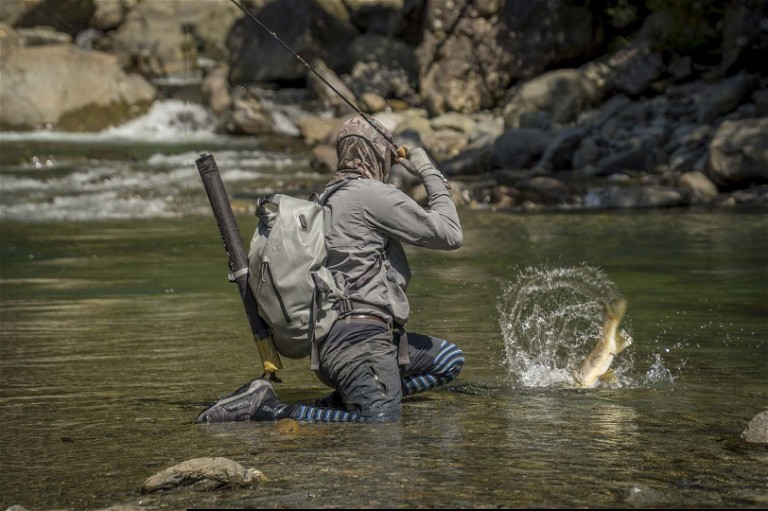
Fishing the well-aerated and oxygenated heads in high summer usually pays dividends.
The dry/dropper rig is a 99% rig in high summer – it will simply do in 99% of situations! Scaling down the dry indicator to a Parachute Adam’s around #14 in size and a #16 or #18 Pheasant Tail nymph will usually bring success on stubborn fish, however don’t be afraid to fish a single nymph to sighted fish in slower water.
Herein lies an extremely valuable skill that you’ll develop over many years – that is reading the take of a trout based on their movement in the water column. Not always obvious, look initially for the white flash of the mouth, a sharp turn towards the area your fly is drifting, or if conditions allow, watching the way tippet reacts to the drift (in slow water this can be very obvious, especially with a lightly weighted nymph).
“ONE SURE-FIRE PLACE ON MANY RIVERS WHERE YOU WILL FIND TROUT IN SUMMER IS THE ‘DROP-OFF’ ZONE – THAT AREA WHERE A RIVER’S FASTER WATER SPILLS OVER INTO A DEEPER POOL.”
Trout become acutely aware of their surroundings in low water conditions, making them cautious and selective in their feeding habits. Many will argue that ultra-thin fluorocarbon tippets are a necessity, however I have personally seen absolutely zero evidence fluorocarbon provides any benefits over mono in any real-world, on-river situation ever, even when presenting to the fussiest of trout! Where fluorocarbon does excel is where you require ‘leader sink’ to avoid the shadows that are cast by a tippet resting on the water’s surface, particularly visible in still water situations such as when fishing small dry flies. This “fluorocarbon is superior” myth has been disproven again and again on hugely selective trout over the years by many experienced anglers. Fluorocarbon does offer a slight edge over mono in abrasion resistance however, but I personally favour the subtle stretch, shock absorption and far superior knotting characteristics of monofilament over highly strung fluorocarbon tippets, especially on hooksets in big water, and additionally when fishing large, air-resistant cicadas through the height of summer where stress on knots and tippet through continued hinging is experienced.
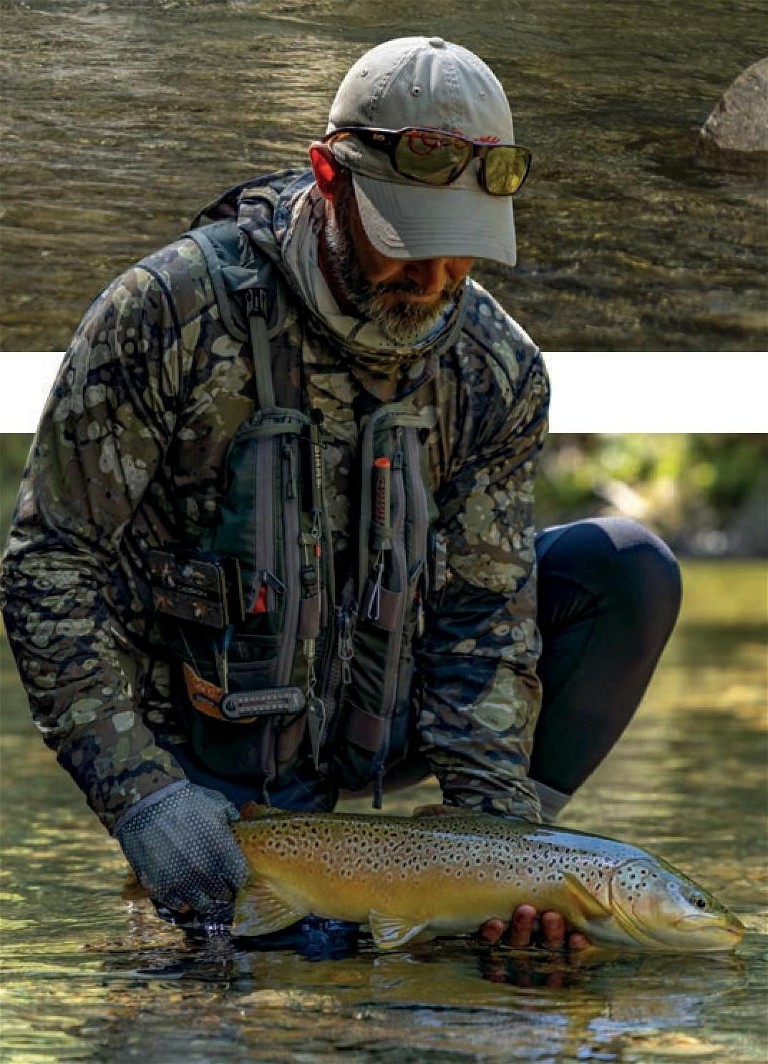
Subtle clothing in dull tones is a must for high-summer trout.
Then there is the cost associated with fluorocarbon tippet – it’s not cheap! Monofilament is far less expensive than fluorocarbon in comparison. When using flies that might encounter snags or get lost in the course of certain situations, this cost factor should be a consideration. Using monofilament tippet can simply be more economical for anglers who go through tippet regularly.
One of the most overlooked facets of fly fishing is polaroid glasses! Seeing your quarry is absolutely paramount and a good pair of glass lenses is an investment you won’t regret. We’re not talking cheap polycarbonate glasses here. Brand name polycarbonate (plastic) glasses can run to over $300 and are, in reality, little different from a $20 pair of service station polaroid glasses bar the exception of a well-established fashion logo and some slick marketing speak! But with optically correct glass, photochromatic lenses, the difference is night and day, and a good pair of glass lens polaroids will outlast cheap polycarb glasses by many, many years if looked after. I find an amber lens in photochromatic most beneficial on summer trout and low water, and in fact all year round!
Lastly, a few other really important factors for highsummer fishing – sunscreen and fish handling. Anglers by nature are exposed to the sun far more than many other sports, so slip, slop, slap that sunscreen on to reduce the chance of melanoma in later years. Oh, and make sure you keep hydrated!
Releasing trout in warm water during summer demands extra care to ensure their survival and, ultimately, the productivity and ongoing sustainability of any given river’s trout population. Minimise fight time by using appropriate tackle to prevent exhausting fish. Wet your hands before handling them to avoid removing the protective slime layer on their skin and keep the trout in the water as much as possible, handling them gently with wet hands or using a rubberised net. Revive the fish by holding it facing upstream in slow-moving water until it regains strength and swims away on its own.
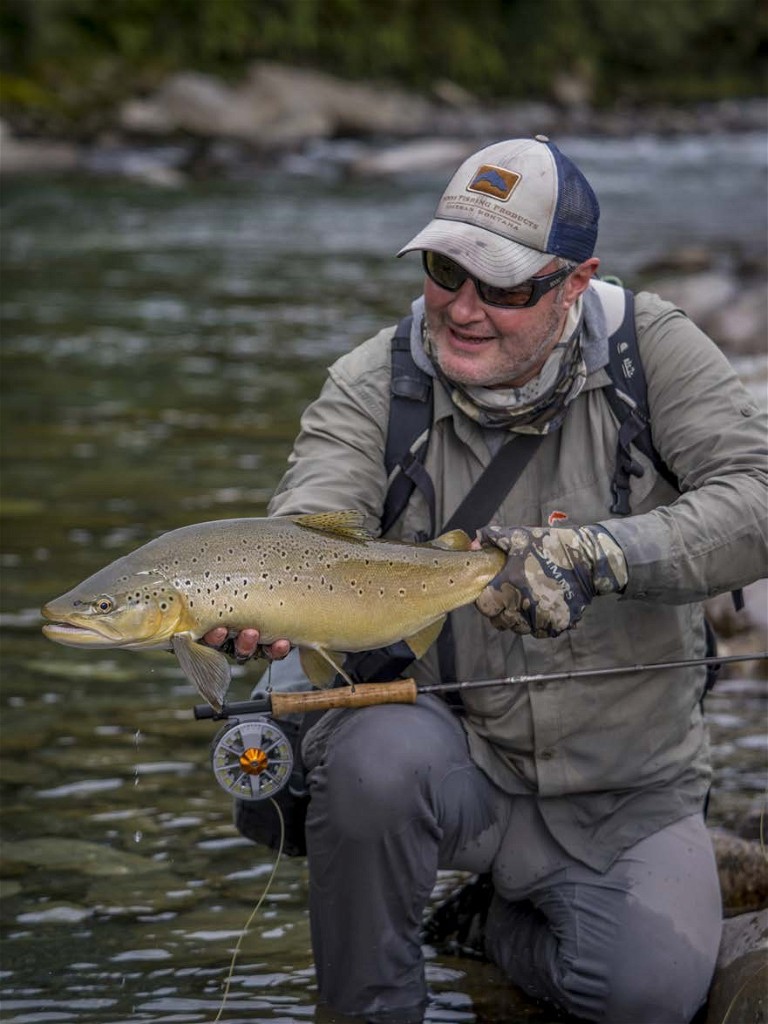
“ TROUT BECOME ACUTELY AWARE OF THEIR SURROUNDINGS IN LOW WATER CONDITIONS, MAKING THEM CAUTIOUS. ”
The pursuit of these finicky high-summer fish demands an intimate understanding of the river ecosystem, a keen eye for observation, and the ability to adapt to changing conditions. As you embark on any adventure this summer season, be prepared to refine your skills and savour the satisfaction that comes from fooling a wary trout in the subtle dance between angler and fish.